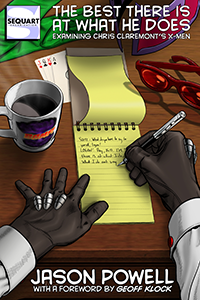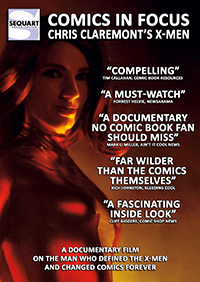Mark Millar’s Old Man Logan is a bold, gripping adventure comic set against a western-style post-apocalyptic background featuring once-mighty heroes clinging to the last vestiges of their former glory. It makes Chris Claremont’s Days of Future Past look positively rosy in its depiction of the future of the X-Men, and it is the inspiration for the critically-acclaimed film set to be released this weekend. Published in 2008 (and followed up by other comics creators’ take on the premise), it showed just how far superhero mythology could be pushed, and succeeded in the seemingly impossible task of making Wolverine even more tough and bitter than we’ve seen him before.
[Though this is a comic from 2008, we should, just in case anyone gets upset, issue a SPOILER alert.]
Those looking for the complex, multi-layered intellectual poetry of Alan Moore or the grim, violent deconstruction of Frank Miller will find neither in Mark Millar. This is a creator who loves the good old-fashioned adventure thrills of silver and bronze age comics — heck, he wrote a comic literally named “Kick-Ass”. So, often Millar is critiqued for simply being himself and not some other kind of artist. Taking all that into consideration helps to explain the slightly odd tone of Old Man Logan, which balances grim nihilism with exuberant punch-ups featuring Jack Kirby-inspired compositions (courtesy of Steve McNiven with inker Dexter Vines and colourist Morry Hollowell).
When we first meet Wolverine, it’s clear that something has gone wrong. His traditional yellow suit in tatters, he wanders through a forest at night and literally throws himself in front of a train. We then cut forward about 50 years to see the titular character, now just going by “Logan”, homesteading in a post-apocalyptic wild west (actually, what used to be Sacramento). With a wife and family and a haunted past, this Logan is torn straight from the world of the classic western, and the iconography is put to full use. In this dark desert world, former super-villains like Dr. Doom and Kingpin serve as landlords for broken-down former heroes. Logan’s landlord is none other than Bruce Banner, who has created an inbred brood with his cousin Jennifer Walters (She-Hulk), and Logan is in the grim position of being short on the rent. The fight with Banner’s hick grandchildren that ensues reveals that Logan’s healing powers aren’t what they once were, and as he recuperates in bed, a visiting Hawkeye (now, ironically, blind) offers him a job delivering a package to the East Coast that pays enough to cover Logan’s bills. Logan reluctantly accepts, and thus the overall narrative structure of the comic kicks in: an episodic road trip across a devastated America with two aged former super-heroes.
A big part of the story of Old Man Logan is revealing precisely how the world came to be the way it is, and what happened to all the super-people who used to populate Marvel’s comic universe. This version of Logan has taken a vow to never fight back and to never harm another being again, which itself is a big hint for those seeking an explanation for the current state of the world. Hawkeye, too, faces the consequences of his past, as he and Logan rescue his daughter Ashley — the granddaughter of Spider-Man — from the Kingpin. When Ashley flat-out kills Kingpin in a fit of rage and threatens to kill her father to boot, Logan is sadly forced into action to come to his rescue, even though he declares, “I’d rather die than pop these claws again.”
The Inbred Banner Family
The book alternates between exciting action sequences and some very brutal violence, rendered in a classic comics style. But what makes the story compelling is how Millar reveals, one layer at a time, the source of Logan’s guilt and shame, as the narrative pushes him towards the inevitable dust-up with first the Red Skull (now the President) and, of course, The Hulk. It isn’t until part 5 of this eight-part run that the secret is revealed, namely that Wolverine was tricked into murdering the X-Men in cold blood through the mind control powers of Mysterio, the Master of Illusions. That single act led to the downfall of the rest of the super-heroes, such as The Avengers, who were almost entirely wiped out by The Red Skull. The all-consuming guilt of being, in his mind, responsible for the fall of civilization led him first to attempt suicide and then, failing that, renounce his powers forever and spend the rest of his long life atoning for his sins and farming. Logan won’t listen to reason (he wasn’t actually responsible for his actions on that dark night, since he was being manipulated) and is bitter, depressed and hollow.
Logan’s emotional arc is what gives this comic its power, and helps it through some of the more lacklustre episodes, such as when Venom bonds with a Tyrannosaurus Rex, just so we can re-create a sequence from Jurassic Park. At times, the book does feel like it’s trying a bit too hard to shove in as many cameos as possible from the Marvel comics universe (Emma Frost seems particularly shoehorned in). The narrative itself is something of a Maguffin, as it’s not until very late in the run that we find out exactly what Hawkeye is delivering to the East Coast (by which time most readers have probably forgotten about the original mission). It turns out that it’s a collection of vials of super-soldier serum for undercover S.H.I.E.L.D. agent Tobias, ostensibly to raise an army against Red Skull. But Tobias reveals that he’s working for Red Skull and kills Hawkeye, leading to the Marvel-reference-rich fight between Logan and Red Skull featuring, among other things, the delicious sight of Logan wielding Captain America’s shield and wearing Iron Man’s armour (both of which had been stolen by Red Skull after the fall and kept as trophies in the White House). No points for guessing that, for the climactic final battle, Logan goes full Wolverine, pulling out the claws and offering the classic quip, “No more games, no more talking… I’m just here to kill you people.”
Old Man Logan is essentially a super-hero, super-powered version of Unforgiven, and just like that classic western, when the fallen hero finally turns bad and returns to his former ways, we watch with a mixture of revulsion and exhilaration. The final panels are straight-up pulls from western iconography, as Logan literally dons a cowboy hat and rides off into the sunset on a horse, determined to go about the world fighting for the side of good.
At the end of the day, Old Man Logan doesn’t add up to very much, in intellectual or philosophical terms. Its thesis (that sometimes you have to be bad to be good) is simple enough, and the story structure is that of an episodic road movie. Some of the adventures are more interesting than others, but the character of Logan himself is never less than compelling. Millar is simply presenting a good, solid, enjoyable superhero comic, with some intriguing twists. It doesn’t have the emotional complexity of Days of Future Past (which wonderfully tracked the coming-of-age of Kitty Pryde) or the social resonance of God Loves, Man Kills, but it does offer the genuine pleasure of seeing Logan in a different context, the foundation of his character challenged to their core.
How much the upcoming film actually borrows from this story remains to be seen, but based on the footage release thus far, it seems a safe bet that it takes the setting, the tone, and the basic road-trip story structure from Old Man Logan, flying in the additional element of X-23 and swapping out Hawkeye with Professor X. It’s impossible to say whether reading the comic will spoil anything further about the film, but that hardly matters. Based on early box office pre-sales, Logan will be a resounding success and will connect with an audience who have never read a Wolverine comic. But if the notion of a dark, wild-west, Mad Max-style Logan appeals, the comic Old Man Logan fits the bill.






















































